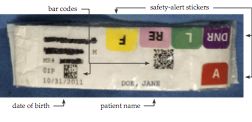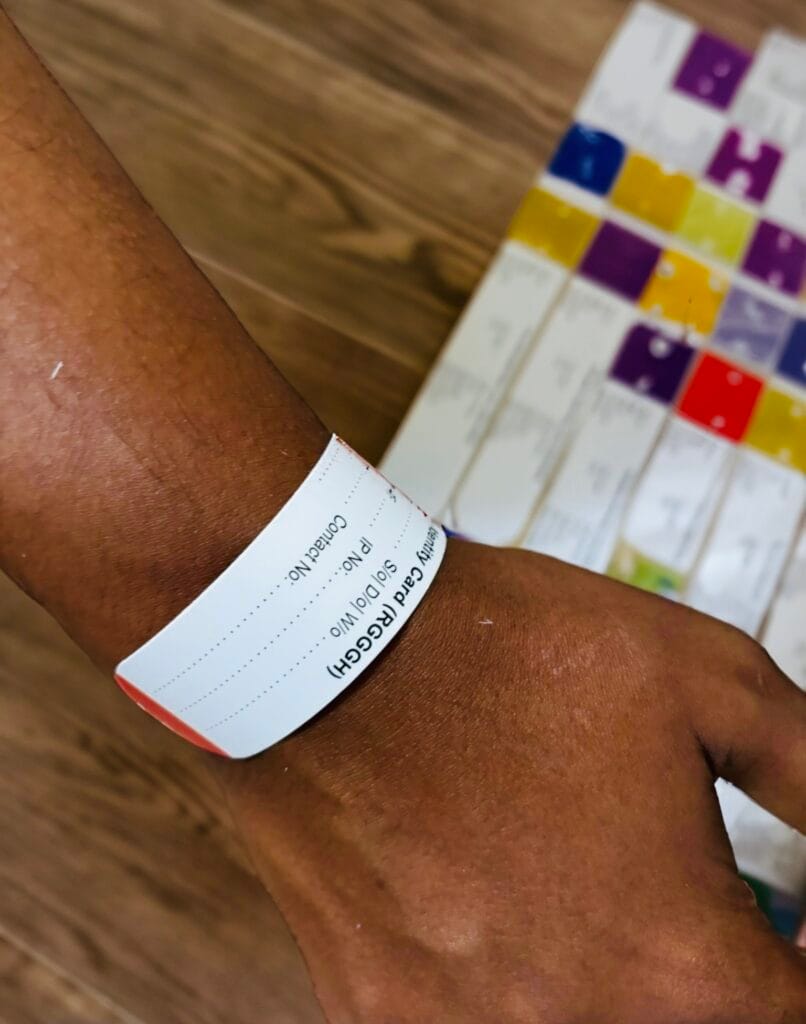Enhancing Security: The Relevance of Patient Identification Bands in Medical Care
In the realm of health care, the efficiency of patient identification bands can not be overstated, as they offer as an essential safeguard versus misidentification and subsequent mistakes. These bands, frequently forgot, contain important info that is important for making sure client safety and security and optimum therapy end results. The execution of efficient recognition protocols positions a number of obstacles that medical care providers need to browse. As we discover the diverse duty of these bands, it comes to be obvious that their value prolongs past plain recognition, raising concerns concerning best techniques and future advancements in client safety.
Summary of Individual Recognition Bands
Patient identification bands play a critical role in making certain the safety and security and accuracy of person treatment in medical care settings. These bands, normally worn on the wrist or ankle, serve as a vital tool for verifying person identification, thus lessening the risk of mistakes in treatment, medicine administration, and other healthcare treatments. Made from long lasting materials, patient identification bands frequently include necessary information such as the person's name, date of birth, clinical document number, and barcodes or QR codes for scanning.
The implementation of person recognition bands is crucial in numerous health care environments, consisting of health centers, outpatient facilities, and long-lasting treatment institutions. They contribute to an organized strategy in client administration, enabling healthcare specialists to promptly and properly determine people, especially in high-pressure situations where quick decision-making is important.
In addition, making use of these bands is aligned with regulatory standards focused on improving client safety and security - Patient Identification Band. By ensuring that each person's information is easily available and quickly proven, doctor can preserve a high requirement of care, minimize the incidence of unfavorable occasions, and cultivate a society of security within health care institutions
Advantages of Accurate Recognition
Accurate recognition is basic to enhancing patient safety and security and care high quality in healthcare settings. It offers as the very first line of defense against mistakes that could lead to unfavorable person results. By making sure that each patient is appropriately recognized through dependable methods, such as patient identification bands, doctor can substantially decrease the danger of misidentification, which can cause unacceptable therapies, medicine mistakes, and also medical mix-ups.
Moreover, exact client identification promotes effective communication amongst medical care groups. When all personnel can continually recognize clients, they can share essential information much more effectively, causing far better sychronisation of care. This is specifically crucial in emergency situation situations where prompt treatments are important.
In addition, exact recognition sustains compliance with regulative criteria, thereby decreasing the risk of legal consequences for medical care centers. It fosters depend on in between patients and healthcare carriers, as clients really feel extra secure knowing that their identifications are being protected.

Usual Difficulties Faced
Ensuring reliable person recognition in medical care settings offers a range of challenges that can endanger safety and security and care quality. People may get here in a state of confusion see here now or distress, making exact recognition tough.
Another obstacle is the reliance on human factors in identification treatments. Medical care experts may inadvertently misinterpret or overlook recognition methods, specifically in high-stress settings such as emergency situation divisions. This can lead to mistakes, consisting of the management of wrong therapies or medications.
Technological problems also posture obstacles. Although digital health document (EHR) systems are created to simplify individual identification, system blackouts or user mistakes can interfere with the procedure. Furthermore, the physical design of patient ID bands can lead to readability concerns, specifically in cases where bands are harmed or obscured.
Finally, irregular training among staff relating to identification procedures can result in gaps in understanding and technique. Dealing with these challenges is critical for boosting client security and here making certain that recognition bands offer their desired function properly.
Finest Practices for Application
To properly implement patient recognition bands in medical care setups, organizations should take on a complex strategy that focuses on standardization, technology, and training combination. Standardization entails establishing clear procedures for the layout, application, and usage of identification bands across all departments. This guarantees uniformity and decreases the threat of errors linked to variations in band types or classifying techniques.


Training is crucial for all medical care team to guarantee they recognize the value of accurate person recognition, exactly how to correctly apply and check out recognition bands, and the procedures to adhere to in case of disparities. Routine workshops and correspondence course can strengthen this knowledge and advertise a society of safety and security.
Technology integration plays an essential duty in boosting the performance of person recognition bands. Making use of barcode scanning or RFID technology can simplify the identification process, enabling real-time confirmation of client identifications. In addition, electronic health and wellness record systems ought to be configured to include signals for mismatches in between the recognition band and person data.
Future Trends in Client Security
As healthcare continues to advance, the emphasis on person security is most likely to intensify, driven by developments in technology and a better understanding of systemic threats. Emerging fads suggest a shift in the direction of more integrated systems that description take advantage of data analytics, expert system, and artificial intelligence to enhance patient recognition processes. These technologies can aid recognize potential security problems prior to they rise, consequently reducing mistakes connected with misidentification.
Moreover, the application of blockchain technology may change just how patient data is firmly shared among medical care service providers, guaranteeing that recognition bands are regularly precise and up-to-date. This will certainly not only enhance individual safety but additionally assist in seamless communication throughout multidisciplinary groups.

In enhancement, the expanding concentrate on personalized medication is expected to influence client safety methods. By integrating demographic and genetic information into identification systems, medical care professionals can customize treatments better, minimizing the risks of damaging reactions due to misidentification.
Final Thought
To conclude, client identification bands function as an essential part in enhancing safety within health care atmospheres. By promoting exact person recognition, these bands substantially lower the risk of mistakes connected with misidentification, improper treatments, and medicine management. Despite challenges in application, adherence to ideal techniques and the integration of arising innovations can better improve their effectiveness. Inevitably, the ongoing emphasis on durable recognition procedures will add to enhanced patient results and overall safety in health care setups.
In the world of health care, the efficacy of client recognition bands can not be overstated, as they serve as a basic secure versus misidentification and subsequent mistakes.Individual identification bands play an essential duty in guaranteeing the safety and security and precision of client treatment in healthcare settings. Made from sturdy materials, individual recognition bands typically consist of important info such as the patient's name, date of birth, medical document number, and barcodes or QR codes for scanning.
By making sure that each client is properly recognized via trustworthy means, such as person identification bands, health care companies can considerably minimize the risk of misidentification, which can lead to unacceptable treatments, medication errors, and also medical mix-ups.
In verdict, patient identification bands serve as an essential part in enhancing safety within health care atmospheres. Patient Identification Band.